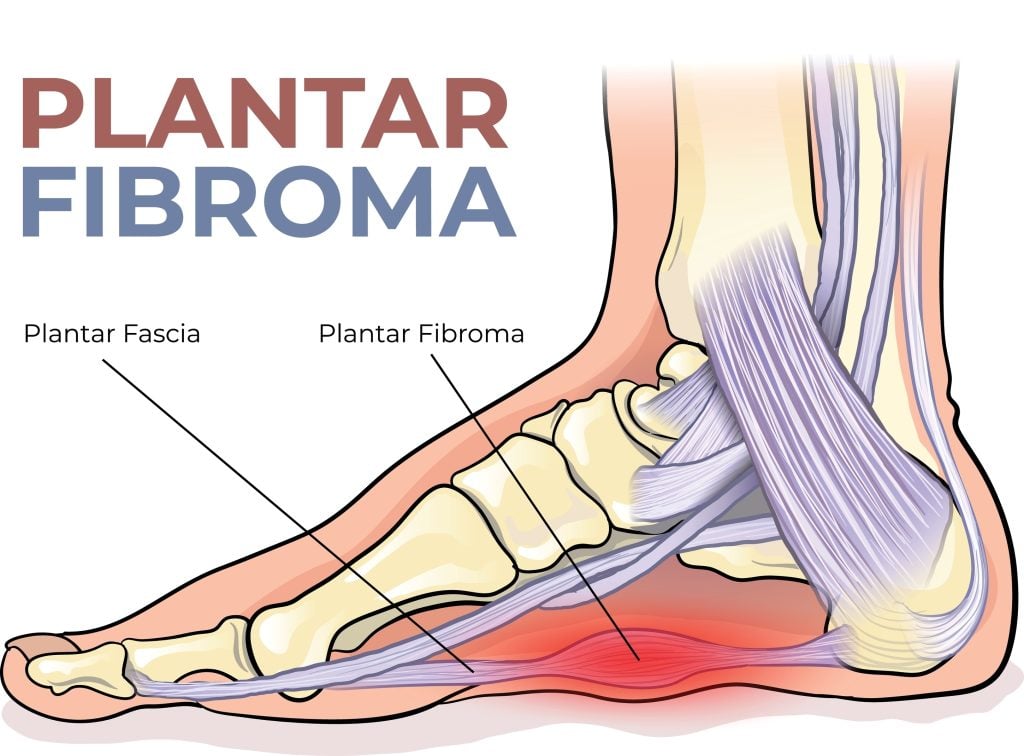Discovering a firm lump under your foot can be concerning and uncomfortable, similar to a pebble in your shoe that refuses to move. If you’ve noticed a growth in the arch of your foot that doesn’t seem to budge, you might be dealing with a plantar fibroma—a benign tumour that develops within the plantar fascia tissue.
While the word “tumour” can sound alarming, you’ll be relieved to know that podiatrists have several effective methods of diagnosing and treating this condition. Understanding your options is the first step toward reducing this bothersome foot condition.
Key Takeaways
- Podiatrists diagnose plantar fibroma with physical exams and may use imaging techniques like MRI or ultrasound.
- Podiatrists offer custom orthotics to provide arch support and reduce discomfort.
- Physical therapy can help stretch and strengthen the plantar fascia to alleviate pain.
- You may administer corticosteroid injections to reduce inflammation and pain in the affected area.
- It is prudent to consult a podiatrist if persistent foot lumps are causing pain or mobility issues.
Lump Inside Foot Arch? Identifying Plantar Fibroma
Feeling a lump inside your foot’s arch can be concerning and uncomfortable. If you’ve noticed a growth in the arch of your foot, it might be plantar fibroma. This benign mass, which typically arises from the plantar fascia, can occasionally feel like knots in the arch of your foot.
Experiencing such a fibroma can lead to plantar fibromatosis, a condition characterised by multiple fibromas, which might affect your daily comfort and mobility.

A lump on the instep of your foot isn’t uncommon, and its presence doesn’t always mean you’ll need invasive treatment. Fortunately, there are several treatment options for plantar fascia fibromatosis that aim to alleviate discomfort and halt further growth. As the first line of defence, orthotics often provide much-needed support and cushioning to the affected area.
Physical therapy helps maintain flexibility and reduce pain. In some cases, corticosteroid injections offer relief by decreasing inflammation around the foot fibroma.
Consulting a podiatrist is essential to determining the best treatment for plantar fascial fibromatosis. They’ll help you address and manage this knot inside your foot, ensuring you can step forward comfortably.
Causes of Lumps in Arches of Feet Like Plantar Fibroma
Recognising a lump in your foot’s arch can be concerning, and understanding its potential causes can help ease some of your worries.
Plantar fibromatosis, a condition that causes non-cancerous growth in the foot known as plantar fibromas, is one common cause. These lumps, or nodules, form due to a hyperproliferative fibrous tissue disorder, causing a knot in the plantar fascia. These growths aren’t cancerous but can be uncomfortable and disrupt your routine.

Other rare growths on the arch of your foot, besides plantar fibromatosis, could explain a lump on your upper foot or cysts on the bottom of your feet. Such growths might emerge due to repetitive stress, genetic factors, or even as part of the tissue response to a minor injury.
Fortunately, various plantar fibroma treatments can help manage the discomfort. Options like orthotics, physical therapy, or more targeted plantar fibromatosis treatment methods focus on alleviating pain and improving mobility should these lumps prove bothersome.
Consulting with a healthcare professional ensures you receive the right diagnosis and the most effective treatment tailored to your needs.
Plantar Fibromatosis: Podiatrist Diagnosis Methods
A podiatrist’s diagnosis of plantar fibromatosis typically begins with a physical examination of your foot, focusing on the location and characteristics of the nodule:
- During this examination, your podiatrist will check if the lump is firm, fixed in place, and located along the arch of your foot—all typical signs of a plantar fibroma.
- We will also assess whether you're experiencing any pain or mobility issues.
- To confirm the diagnosis, your podiatrist may order imaging tests. An MRI can help distinguish a plantar fibroma from other types of foot lumps and determine its exact size and location.
- You might also use ultrasound imaging to confirm the benign tumour's attachment to the plantar fascia.
Once diagnosed, your podiatrist will discuss treatment options based on the severity of your symptoms. Your podiatrist will also evaluate whether the fibroma is growing or if you have multiple nodules, which can influence the treatment approach.

Painful Knot on the Side of Foot Treatment Options
A painful knot on the side of your foot can be a debilitating condition that affects every step you take. Lumping your upper foot or arch growth is common. Plantar fibromas are benign tumours that can develop on the fascia, causing discomfort and pain.
Luckily, treatment options for a painful knot on the side of your foot are available. Here are some of the possible ways to alleviate your condition:
- Custom orthotics are designed to support the arch and reduce pressure on the fibroma.
- Physical therapy improves mobility and relieves tension in the affected area.
- Corticosteroid injections are used to reduce inflammation and pain.
- Use night splints to stretch the plantar fascia while you sleep.
- Use topical creams or ointments to alleviate pain and reduce inflammation.
Consulting a podiatrist for plantar fibroma treatment can help you determine the best course of action. They’ll work with you to develop a personalised treatment plan that addresses your symptoms and improves your overall foot health.
With proper treatment, you can say goodbye to the painful knot on your foot and enjoy life to the fullest.

When to Consult a Podiatrist for Plantar Fascia Fibroma
While early intervention often leads to better outcomes, knowing when to seek professional help for plantar fascia fibromas can prevent complications and speed up recovery. Even if it’s not causing pain, it’s crucial to have a podiatrist evaluate a firm-to-the-touch lump in your foot arch. These benign tumours can grow larger over time and potentially impact your mobility.

A podiatrist can properly diagnose your condition and develop a personal treatment plan, which may include orthotics, physical therapy, or corticosteroid injections. If conservative treatments fail to provide relief, a podiatrist may recommend surgery in certain cases.
Here are key signs that indicate it’s time to consult a podiatrist:
- The lump in your foot arch has increased or become painful when walking or standing.
- You're experiencing changes in your gait or difficulty wearing certain shoes due to the plantar fibroma.
- Conservative home treatments haven't improved your symptoms after several weeks.
Don’t wait until the plantar fascia fibroma noticeably affects your daily activities. Early professional intervention can help manage symptoms and prevent the need for more aggressive treatments.
If you want the right professional advice on how to treat your foot pain, we currently have a limited offer running to help you out. For just $79 (usually valued at $189), book in online for our Complete Foot Pain Assessment & Treatment Consultation will get:
- Complete In-Depth Foot Pain Examination
- Review of Footwear & Personal Habit Diagnosis
- Treadmill Walking Gait Analysis & Video Assessment
- Complete Foot & Ankle Structural Diagnosis
- Effective Foot Pain Treatment Plan To Get You Walking Pain Free
- Peace of Mind You Know What Is Causing Your Foot Pain & How To Fix It
Foot Pain & Plantar Fasciitis
Understand what causes your foot pain and what you can do to get rid of it once and for all. Find out what treatments can get you back to walking pain free so you can enjoy living an active life again!


Bellevue Podiatry
Bellevue Podiatry has been serving the people of Rosanna and its surrounding suburbs for over 10 years. We have the qualifications, experience and education to effectively treat any lower limb condition or injury that requires expert podiatry care.
Article References:
If you would like a deeper understanding of the treatment podiatrists use for arch pain, please click on the links below:
- https://www.healthline.com/health/plantar-fibroma – Healthline
- https://my.clevelandclinic.org/health/diseases/22104-plantar-fibroma – Cleveland Clinic
- https://www.medicalnewstoday.com/articles/321742 – Medical News Today
- https://www.webmd.com/pain-management/what-is-plantar-fibroma – WebMD
